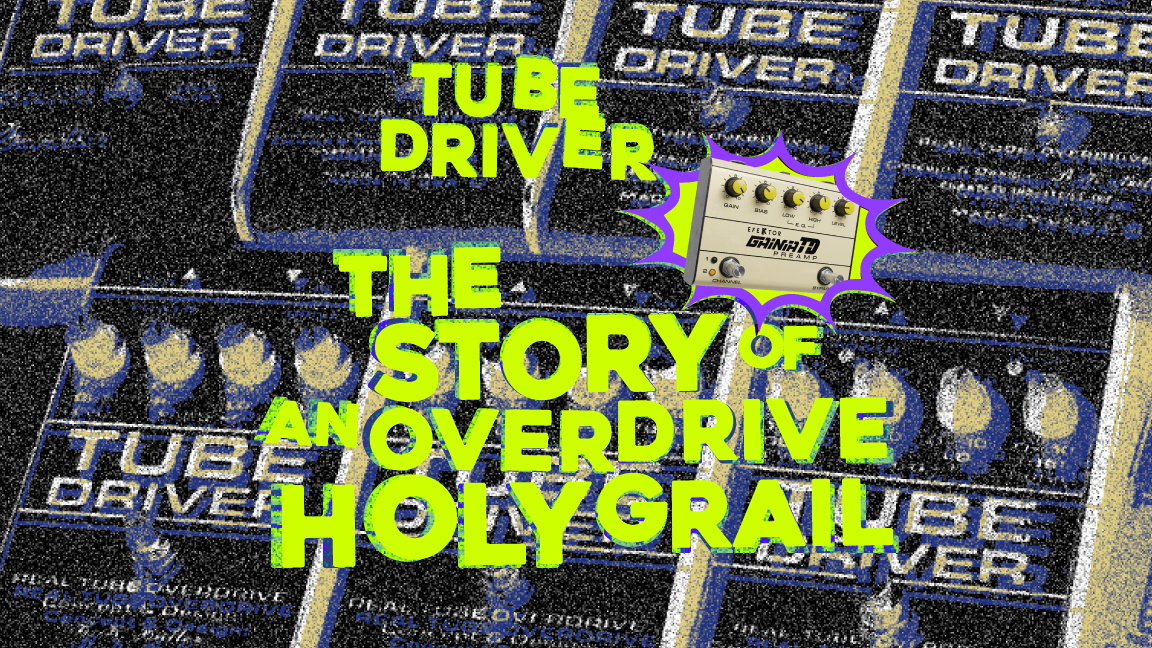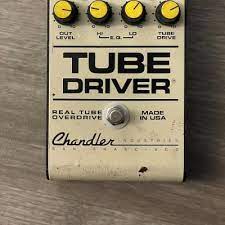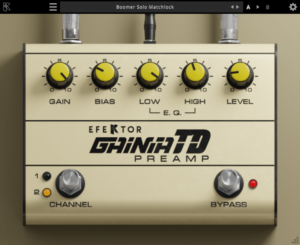
Over the years one legendary overdrive pedal has gained wide popularity and usage among many famous guitar players such as David Gilmour, Eric Johnson, Joe Satriani, Billy Gibbons etc. That pedal is recognizable by its characteristic warm sound generated from a single 12AX7 tube, which determines the essence of the overdrive tone.
This article digs deep in the history , features, and functionality of the Tube Driver bringing a vast guide for those who are enthusiastic and like music very much.
The Beginning of the Tube Driver
Let’s start with the mastermind behind the Tube Driver-B. K. Butler.
View this post on Instagram
He found his work a success when the local guitarists returned to him positive feedback and decided to refine the circuit and create the Tube Driver. That very pedal eventually would become a staple for many guitarists from the past till today.
The Eras of the Butronics and Audio Matrix
The Tube Driver was first produced under the Butronics brand, featuring three control knobs, blue metal housing, and a 6AV6 or 12AV6 tube. Due to legal issues with Mesa Engineering, Butler created a 59 knob version called the Mini Boogee, which was later renamed the Mini Matrix. The mini Matrix circuit incorporates two 12AX7 preamplifier tubes, and it was from this circuit that the iconic 4-knob Tube Driver would eventually be born.
 Source: Reverb.com
Source: Reverb.com
The legendary 4-knob Tube Driver
The most famous version of the pedal , 4-knob Tube Driver, was designed by Butler in 1983 and produced in 1985. This edition of the Tube Driver utilized an op-amp (operational amplifier or integrated circuit chip) and a preamp tube running on starved voltage to generate distortion. Perhaps the 4-knob Tube Driver could be considered as the most quintessential model, that many guitarists would prefer when it comes to the B.K Butler Tone Driver.
The Era of the Chandler Industries
Chandler Industries began distributing the Tube Driver for B.K Butler somewhere in the middle of the 80s. Their partnership didn’t last longer and they ended it in 1987, with Chandler Industries to retain the rights to the “Tube Driver” name. Thereupon , Chandler Industries continued to produce the Tube Driver with a slightly altered circuit design.
The Chandler Tube Driver / Real Tube Overdrive
Between 1987 and 1989, Chandler Industries produced the Chandler Tube Driver, AKA the Real Tube Overdrive. In this version of the pedal, the circuit retained the use of a single 12AX7 tube. Also featured a power section connected to the pedal.
Differences in EQ Between Versions
With the many opinions of the masses that there are no discernible differences between the B.K Butler and Chandler versions of the Tube Driver, some maintain that the two circuits are not identical and therefore exhibit subtle variations in EQ. Lastly, the perceived differences in sound quality and tone are subjective and very much depend on every individual taste and more or less personal preference.
The Legacy of the Tube Driver
There was a time when Chandler Tube Driver was discontinued in the early 1990s, but the incredible pedal has remained influential and is still a sought-after piece of equipment among guitarists today. Among the many reasons for its long lasting popularity, there are its powerful overdrive capabilities that can range from mellow and low- gain crunchy overdrive to cranked up high gain distortion with plenty of volume.
Famous Users and Applications
Numerous renowned guitarists have found it as a staple.
For David Gilmour, the legendary Pink Floyd Guitarist it was usable for creating atmospheric, soaring leads and lush, rhythm tones. Eric Johnson on the other side has found in it smooth, singing lead tone and frequently utilizes the Tube Driver to achieve his well known signature sound. Also the ZZ Top frontman Billy Gibbons has relied on the Tube Driver for its smooth, creamy overdrive to create his iconic blues-rock sound. We have to mention the Virtuoso guitarist Joe Satriani who used the Tube Driver for its versatility in achieving a wide range of overdrive tones, from subtle crunch tones to aggressive lead distortion.Exploring the Tube Driver in Software Version
In addition to its hardware counterparts, the iconic Tube Driver has also made its way into the digital realm with software emulations. Several companies and developers have sought to recreate the unique characteristics and tonal qualities of the Tube Driver in virtual form, offering guitarists and music producers the convenience and flexibility of incorporating this legendary overdrive sound directly into their digital setups.
Software emulations of the Tube Driver aim to capture the essence of the original pedal, replicating its warmth, responsiveness, and distinct tube-driven overdrive. By utilizing advanced digital modeling techniques, these virtual Tube Driver plugins strive to provide an authentic experience, allowing users to achieve the sought-after tones associated with the classic hardware version with convenience of the digital realm, such as portability, presets, integration, and no necessity in changing components like the tube itself.
While purists may argue that nothing quite matches the tangible experience and nuances of the physical Tube Driver, software emulations have become an increasingly popular and convenient alternative. They offer accessibility to a wider range of musicians, regardless of their access to the original hardware or the limitations of their recording setups.
Among the growing selection of software emulations of the Tube Driver, one notable addition is the Kuassa Efektor Gainia TD. Developed by Kuassa, a renowned company specializing in guitar amp and effects simulations, the Efektor Gainia TD aims to deliver an authentic Tube Driver experience within the digital realm.
Kuassa Efektor Gainia TD faithfully captures the sonic characteristics and tonal nuances of the original Tube Driver, offering guitarists a versatile and powerful tool for crafting their desired overdrive tones. This software emulation meticulously emulates the behavior of the Tube Driver’s tube-driven circuitry, replicating its warm and harmonically-rich overdrive that has made the pedal a favorite among guitar legends.
As technology continues to evolve, software emulations like the Efektor Gainia TD provide an accessible and flexible means to experience the revered Tube Driver sound. While nothing can completely replace the tangible feel of the original hardware, these software versions bring the iconic overdrive within reach of a broader range of musicians and offer a convenient way to tap into the Tube Driver’s legacy in the digital domain.
The conclusion
It will not be exaggeration to say that The Chandler Tube Driver was and is one of the iconic pedals that has left an indelible mark on the world of guitar effects. The versatile tonal capabilities as well as its unique circuitry, on a par with the most influential users, very much solidified its status as a legendary piece of gear. The Chandler Tube Driver remains a highly desirable pedal, which is not to be missed if you like to be different, or if you simply like to emulate the tone of your favorite famous guitarist, or maybe if you just want inspiration to create music, then the Chandler Tube Driver is just what you need.



